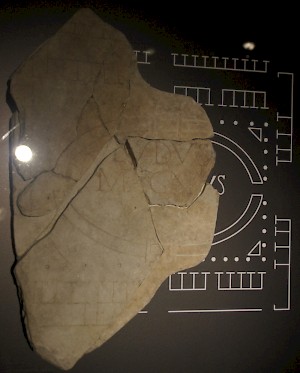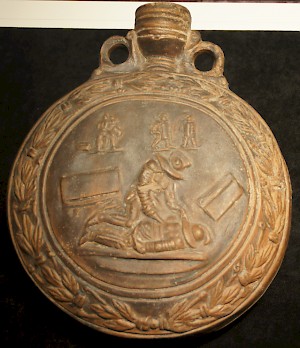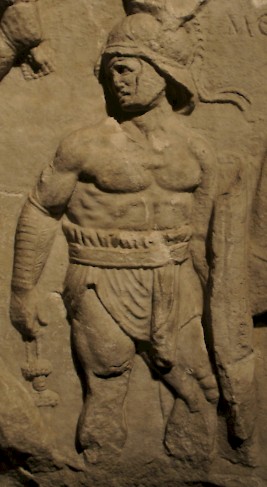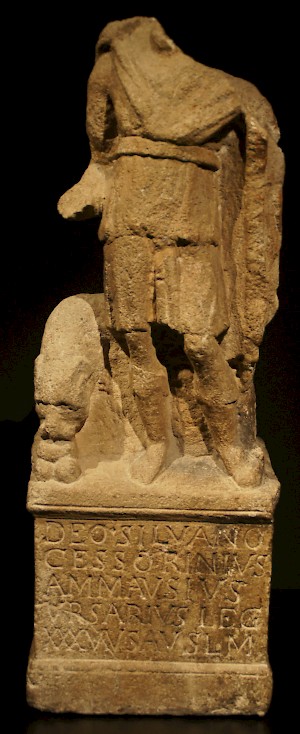Ancient Warfare at the Museum - gladiators!
Last Sunday I visited the ‘Gladiators - heroes of the Colosseum’ exhibition at the Valkhof Museum, Nijmegen. I have to admit that the language and graphics used made me a little wary, but I’m very glad I went. The exhibition is a wonderful collection of gladiator-related artifacts from the Republic through to the Late Imperial era, with an obvious emphasis on the early Imperial period. There are reliefs, mosaics, equipment, statuary, bronzes, earthenware and even a few frescoes. If you’ve got the chance to go to Nijmegen before March 3rd, do so. If not, well, I’ve got so many photos now, a gladiator theme in either Ancient Warfare or Ancient History is now a lot easier to illustrate. I’m sure you’ll see bits and pieces come by in the future. For now, here are a few choice picks from many options…
 Amphitheatres have been found throughout the empire in or near cities of any decent size (ie a few thousand inhabitants). Nijmegen, home to a variety of campaign, auxiliary and legionary bases from the Augustan era onwards not to mention the Batavian capital, certainly had such an arena. It’s been located though nowadays only very few traces remain visible. This bronze vessel, found in the area, shows two gladiators separated by the referee.
Amphitheatres have been found throughout the empire in or near cities of any decent size (ie a few thousand inhabitants). Nijmegen, home to a variety of campaign, auxiliary and legionary bases from the Augustan era onwards not to mention the Batavian capital, certainly had such an arena. It’s been located though nowadays only very few traces remain visible. This bronze vessel, found in the area, shows two gladiators separated by the referee.
 Bronze and earthenware statuettes of gladiators are common enough, and the pose and shape of this hoplomachus certainly ring a bell. But I don’t think I’ve ever seen any with such obvious traces of paint!
Bronze and earthenware statuettes of gladiators are common enough, and the pose and shape of this hoplomachus certainly ring a bell. But I don’t think I’ve ever seen any with such obvious traces of paint!
 Well over 1000 fragments of the Forma Urbis Romae (a marble engraving of a map of the city of Rome) survive. This particular piece shows the outine of the Ludus Magnus, the Great Gladiator training school in Rome (and is clearly designated as such).
Well over 1000 fragments of the Forma Urbis Romae (a marble engraving of a map of the city of Rome) survive. This particular piece shows the outine of the Ludus Magnus, the Great Gladiator training school in Rome (and is clearly designated as such).
 Speaking of things I’ve not seen before: I don’t remember seeing an earthenware field flask before, let alone one so extensively and beautifully detailed, showing the very end of a fight between two gladiators. They are usually identified as a murmillo (standing) and a thraex (lying down), but the size and shape of the shields are a bit on the large side for the latter type of gladiator.
Speaking of things I’ve not seen before: I don’t remember seeing an earthenware field flask before, let alone one so extensively and beautifully detailed, showing the very end of a fight between two gladiators. They are usually identified as a murmillo (standing) and a thraex (lying down), but the size and shape of the shields are a bit on the large side for the latter type of gladiator.
 This large (several meters across) relief is the Roman equivalent of ‘a day at the races’ - it shows the entire program of ‘Games Day’. At the top is the pompa, the procession with gladiators, asisstants carrying their arms and armour. On the middle row is the actual gladiatorial combat with at its centre the moment victory is gained and on the bottom row the venationes, the animal hunt takes its course.
This large (several meters across) relief is the Roman equivalent of ‘a day at the races’ - it shows the entire program of ‘Games Day’. At the top is the pompa, the procession with gladiators, asisstants carrying their arms and armour. On the middle row is the actual gladiatorial combat with at its centre the moment victory is gained and on the bottom row the venationes, the animal hunt takes its course.
 Third item I don’t remember seeing before: an apparent sword loop shown on a larger relief. It makes sense to have one, but I can’t recall ever having seen any, certainly not in the context of the Roman army. You’d think a simple device like that would be useful for cavalry troopers and infantrymen as well as gladiators.
Third item I don’t remember seeing before: an apparent sword loop shown on a larger relief. It makes sense to have one, but I can’t recall ever having seen any, certainly not in the context of the Roman army. You’d think a simple device like that would be useful for cavalry troopers and infantrymen as well as gladiators.
 And finally, this is Ancient Warfare after all, a Roman military relief, but it too is related to gladiators. This is a dedication to the ‘forest god’ by a legionary of Legio XXX Victrix Severiana Alexandriana (which means it can be dated to the reign of Severus Alexander AD 222-235). The link to gladiatorial games is in the special task Cessorinius Ammausius had in this legion: he was ursarius, “bear catcher”, a job that’s only mentioned in one other inscription. The Lower Rhine area was apparently good hunting grounds for bears (it’s not anymore, at all…). Ammausius doesn’t mention any other rank, so he was probably an immunes, exempt from fatigue duties, patrols, etc. The latter is a very interesting particularity of the Roman army and worth an entry in the Roman Army in Detail series…
And finally, this is Ancient Warfare after all, a Roman military relief, but it too is related to gladiators. This is a dedication to the ‘forest god’ by a legionary of Legio XXX Victrix Severiana Alexandriana (which means it can be dated to the reign of Severus Alexander AD 222-235). The link to gladiatorial games is in the special task Cessorinius Ammausius had in this legion: he was ursarius, “bear catcher”, a job that’s only mentioned in one other inscription. The Lower Rhine area was apparently good hunting grounds for bears (it’s not anymore, at all…). Ammausius doesn’t mention any other rank, so he was probably an immunes, exempt from fatigue duties, patrols, etc. The latter is a very interesting particularity of the Roman army and worth an entry in the Roman Army in Detail series…

